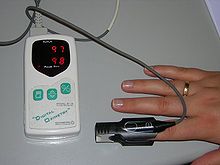
Back نقص التهوية Arabic Hipoventilacija BS Hipoventilació Catalan Hypoventilation English Hipoventilación Spanish هیپوونتیلاسیون Persian Hengityslama Finnish Hypoventilation French דיכוי נשימתי HE 呼吸抑制 Japanese
| Klassifikation nach ICD-10 | |
|---|---|
| E66.2 | Übermäßige Adipositas mit alveolärer Hypoventilation |
| G47.3 | Schlafapnoe |
| R06 | Störungen der Atmung |
| ICD-10 online (WHO-Version 2019) | |


Mit Hypoventilation bezeichnet man eine für den Gasaustausch von Organismen unzulängliche Atmung, die zu oberflächlich und/oder zu langsam sein kann. Dadurch kommt es im Blut zu einem Abfall des Sauerstoff-Gehalts sowie einem Anstieg des Kohlenstoffdioxids (Hyperkapnie) mit respiratorischer Azidose.[1] Die Veränderungen können lebensbedrohlich sein.
Zur Diagnose dient die Blutgasanalyse[1] oder als kontinuierliches und nicht-invasives Monitoring die Pulsoxymetrie[1] oder transkutane Kohlenstoffdioxidpartialdruck-Messung (pCO₂).
- ↑ a b c P. Marino: Das ICU-Buch. 4. Auflage. Urban & Fischer, München/Jena 2008, ISBN 978-3-437-23161-2.